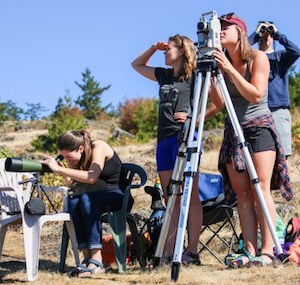Last fall’s innovative 2-month voluntary slow-down of ships traveling to and from the Port of Vancouver was successful on one count—average overall shipping noise was reduced by 44%—but a stark absence of the normally abundant resident orcas stymied the equally important second line of inquiry: how would reducing the noise level, but spreading more moderate noise over longer time periods, affect orca behavior?
About 60 percent of the ships transiting Haro Strait complied with the voluntary speed restrictions; even this level of participation succeeded in reducing the overall level of ship noise by 2.5 decibels, very close to the 3dB target set by the International Whaling Commission a decade ago. Thanks to the logarithmic scale of decibel measurements, a 3dB reduction amounts to cutting the sound energy in half. This is great news, a real-world confirmation that the noise of global shipping can be reduced relatively easily—albeit by increasing transit time.
It’s this element that marine mammal experts remain uncertain about. Slower ships remain audible for longer during their passage, though at a lower volume; perhaps worse, the quiet periods between the passage of large ships became notably shorter and noisier, thanks to the lingering presence of ships in the mid-distance. What is more livable: a constant lower noise level or trading off louder periods for interims with relatively little noise? As researcher Scott Veirs notes. “I’m not sure which I would prefer, but we definitely don’t know which the whales prefer.”
 An excellent in-depth article on the Seattle nonprofit news site Crosscut tells the tale of the researchers waiting on shore to monitor whale behavior. But rather than seeing whales on most days, there were no orcas at all during the first month of the slowdown, and only six appearances in the second month. A stark lack of salmon kept the orcas out of the area; salmon shortages are the primary factor driving the decline in the Southern Resident orca population. A recent modeling study by a diverse group of researchers suggested that increasing salmon numbers by 15% while also reducing shipping noise by half would allow the resident population to recover. (The decrease in salmon numbers is compounded by a boom in populations of seals and sea lions, who also eat salmon.)
An excellent in-depth article on the Seattle nonprofit news site Crosscut tells the tale of the researchers waiting on shore to monitor whale behavior. But rather than seeing whales on most days, there were no orcas at all during the first month of the slowdown, and only six appearances in the second month. A stark lack of salmon kept the orcas out of the area; salmon shortages are the primary factor driving the decline in the Southern Resident orca population. A recent modeling study by a diverse group of researchers suggested that increasing salmon numbers by 15% while also reducing shipping noise by half would allow the resident population to recover. (The decrease in salmon numbers is compounded by a boom in populations of seals and sea lions, who also eat salmon.)
The Crosscut piece zeroes in on the questions facing British Columbia, where new oil and gas ports and expansion of existing pipelines could add even more ships to the mix:
Piloting his 31-foot research boat Wishart back to Seattle from the San Juan Island study site, Rob Williams mused on his 20 years studying killer whales. “A whole lot of science has been done already,” he said. It may be time to start making some difficult policy decisions about vessel noise, Williams said, and that means weighing safety issues and economic tradeoffs alongside concern for the whales. A number of factors, including the Canadian government’s approval of Kinder Morgan’s pipeline to export oil to Asia, could drive future increases in Port of Vancouver vessel traffic.
“What we have to do next is to have some really uncomfortable conversations. . .about how much of this acoustic space do we think it is fair to ask the whales to give up.” Williams said. “And how much are we willing to give up to have killer whales persist?”
“And those aren’t science questions,” he continued. “They are really tough value judgments.”
